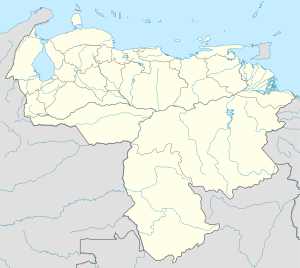Caracas - La Guaira motorway bridges
Caracas - La Guaira motorway bridges |
||
|---|---|---|
| Former Viaducto I | ||
| place | Caracas - La Guaira Highway , Venezuela | |
| construction | Reinforced concrete arch bridges | |
| overall length | 312 m / 242 m / 205 m | |
| width | 20.8 m | |
| Longest span | 152 m / 146 m / 138 m | |
| start of building | 1951 | |
| completion | 1953 | |
| planner | Eugène Freyssinet | |
| location | ||
|
|
||
| Viaducto II and III | ||
Motorway bridges Caracas - La Guaira is the collective name for the three largest bridges on the approximately 20 km long motorway that runs from Caracas , the capital of Venezuela , at an altitude of 760–920 m , along the rugged Tacagua Gorge ( Quebrada Tacagua ) through the Ávila massif to the coastal town of La Guaira with the port and the international airport Aeropuerto Internacional de Maiquetía “Simón Bolívar” .
The motorway, which was built between 1950 and the end of 1953, brought significant relief to the traffic that had previously struggled on a 25 km long, narrow country road with numerous tight curves. The bridges were the largest concrete arch bridges in America when they were completed.
description
The three major bridges on this route were designed by Eugène Freyssinet and his colleague Jean Muller and built by Campenon Bernard . They are usually referred to only with numbers, starting in Caracas:
The bridges are a total of 312 m, 242 m and 205 m long and each consist of a large arch with spans of 152 m, 136 m and 138 m. The arch is formed by three arched ribs made of reinforced concrete . On both sides of these ribs there are three narrow concrete supports that support the elevated, 20.8 m wide deck.
During the construction of the bridges, the supports on the side slopes and the corresponding part of the deck were built first. Then Freyssinet repeated the method he had used in the Orly airship hangars : First, the two outer thirds of the arched ribs were concreted on falsework that did not stand on the valley floor, but merely supported themselves on the fighters and braced from the side pillars. The bracing had to be continuously adjusted according to the progress of concreting and the resulting changes in loads. Then the middle third of the falsework was mounted on the ground, stiffened by a tie stretched between its ends and then lifted into position from the tips of the thirds of the arched ribs that had already been made. By releasing the bracing slightly, a firm and load-bearing connection was created with the outer thirds, so that the middle part could also be concreted.
After the concrete had hardened, the middle section was lowered and reused for the next bridge.
Earthquakes and landslides
As part of the Venezuelan coastal cordillera, the Ávila massif is repeatedly affected by tectonic changes. Since the 1967 earthquake, a hill next to Viaducto I began to shift. The bridge was deformed, but could still be used. Over a longer period of time, broken sewers seem to have additionally destabilized the subsoil. Since 1985, the responsible ministry has considered a collapse of the bridge, but without major maintenance measures being taken.
After further ground movements had occurred over the years, exceptionally heavy rain came in January 2006, followed by landslides that deformed the bridge so that it had to be closed and finally collapsed on March 19, 2006.
A new bridge was built between 2006 and 2007 a little further north on better ground. It is an 803 m long steel-reinforced concrete composite bridge on seven pillars, which was built using cantilever construction.
Web links
Individual evidence
- ↑ Eugène Freyssinet en quelques ouvrages: Trois viaducs sur l'autoroute Caracas-La Guaira, Venezuela, 1951-1953 on the website of the Association Eugène Freyssinet
- ^ Daniel M. Tassin: Jean M. Muller: Bridge Engineer. In: PCI Journal , March – April 2006
- ↑ a b c Yves Guyon: l'homme et son œuvre. In: L'Ingénieur – Constructeur, Revue technique mensuelle n ° 134, March – April 1969; Special edition on Freyssinet and Prestressed Concrete ( digitalisat PDF; 17.6 MB), p. 89 (94 in PDF), in particular p. 91 (97)
- ^ Jean Muller: La conception des ponts. (PDF, 4.7 MB)
- ↑ Ana Elena Azpúrua (ed.): La Caracas-La Guaira, del esplendor a la debacle. Los Libros El Nacional, Caracas 2006, ISBN 980-388-279-1 , p. 23 ( digitized extracts on Google Books)
- ^ Caracas-La Guaira Bridge I. In: Structurae



